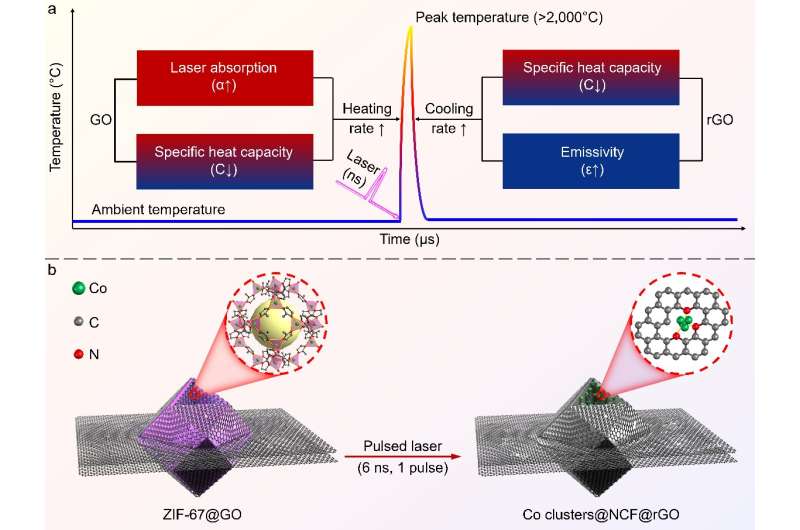This article has been reviewed according to Science X's editorial process and policies. Editors have highlighted the following attributes while ensuring the content's credibility:
fact-checked
trusted source
proofread
Overcoming the trade-off between sub-nanometer size and high metal loading in meta cluster catalysts

Recognizing the ultrafast laser-to-thermal conversion capacity and the impermeable, flexible features of graphene Dr. Ye-Chuang Han and Prof. Zhong-Qun Tian conceived the idea of using the material as the diffusion-constrained nanoreactor for high-temperature reactions.
In one pulse of nanosecond laser irradiation, they found the irradiated area of graphene achieves a surprisingly high heating/cooling rate of 109 °C/s, and named the heating method as graphene-confined ultrafast radiant heating (GCURH). Furthermore, through collaborating with Dr. Jun Yi (co-first author) and Prof. Kostya S. Novoselov, they performed the theoretical calculations and found that such an ultrafast cooling process is in accord with Stefan-Boltzmann law, and radiation became the primary mode of energy release at elevated temperatures.
Given that thermally activated ultrafast diffusion, collision and combination of metal atoms are fundamental processes for synthesizing burgeoning subnanometer metal clusters, and no method has allowed the kinetically controllable synthesis of subnanometer metal clusters while not compromise metal loading.
Dr. Ye-Chuang Han and Dr. Beibei Pang (co-first author, University of Science and Technology of China) demonstrated that kinetics-driven GCURH method is capable of synthesizing subnanometer Co cluster catalysts with high metal loading up to 27.1 wt% by pyrolyzing a Co-based metal-organic framework in microseconds, representing one of the highest size-loading combinations and the quickest rate for MOF pyrolysis in the reported literature.
Overall, this work provides a general strategy to overcome the trade-off between ultrasmall size and high loading in metal cluster catalysts, and holds great promise for the upcoming industrial applications of cluster catalysts.
The work is published in the journal National Science Review.
More information: Ye-Chuang Han et al, Graphene-confined ultrafast radiant heating for high-loading subnanometer metal cluster catalysts, National Science Review (2023). DOI: 10.1093/nsr/nwad081
Provided by Science China Press




















